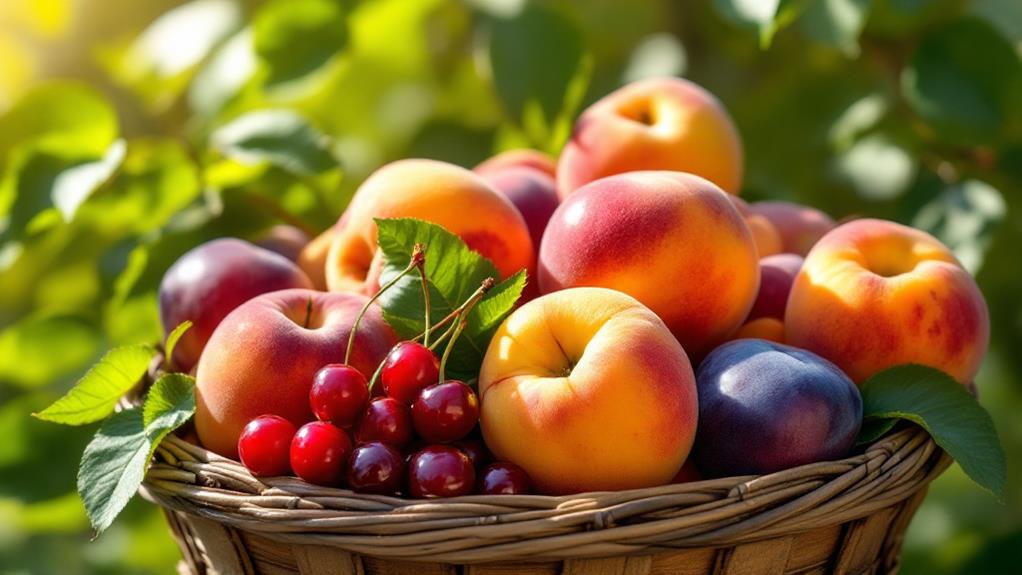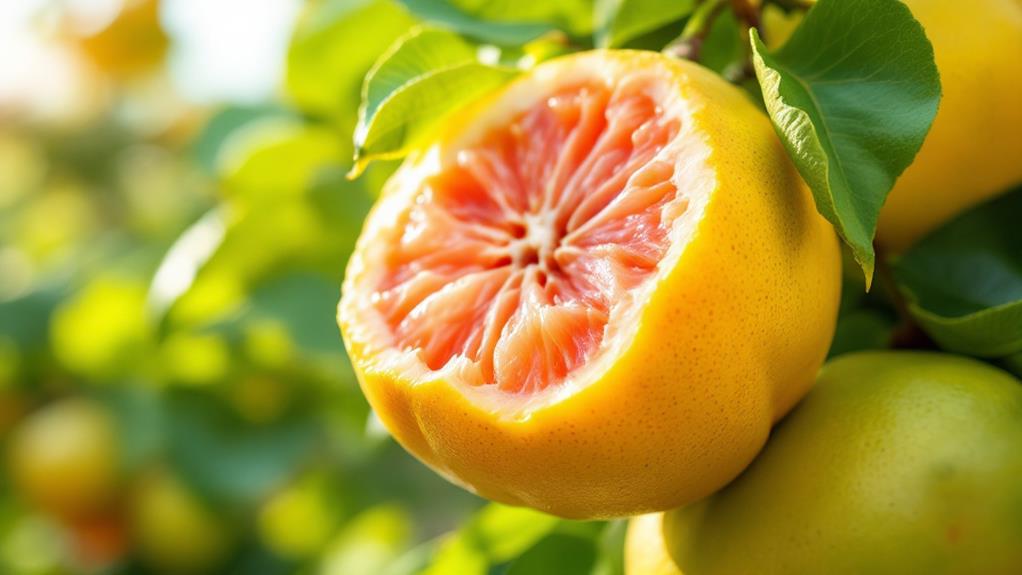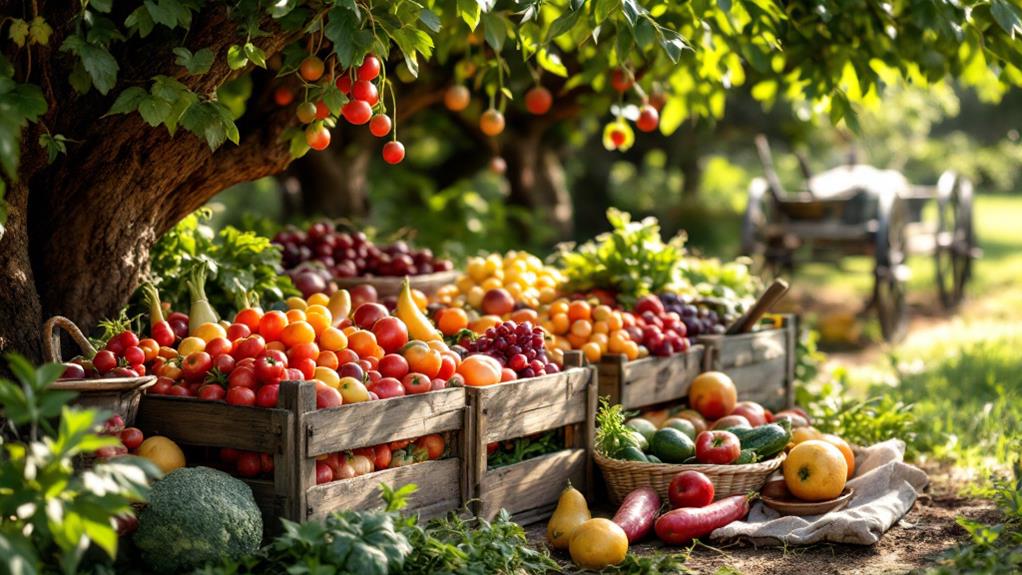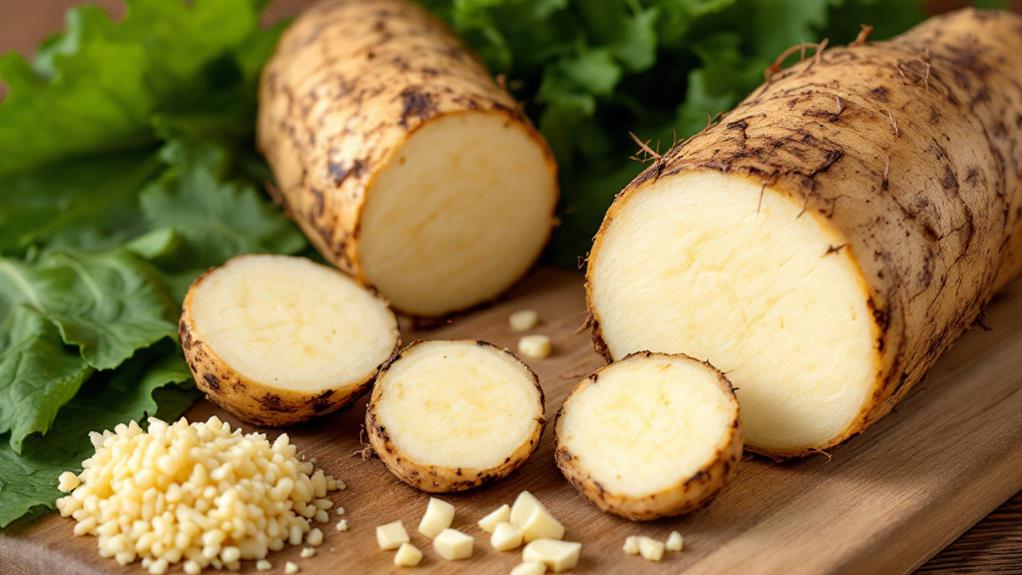10 Exotic Fruits From Indonesia You Need to Try
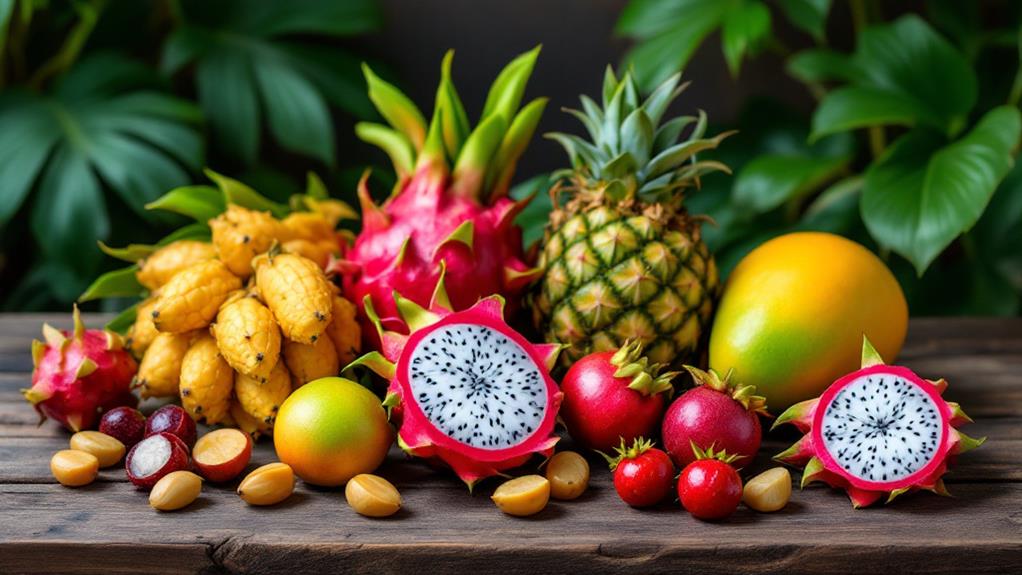
You're in for a treat with Indonesia's exotic fruits. Start with durian, the "king of fruits," known for its strong aroma and creamy taste. Don't miss mangosteen, the "queen of fruits," with its invigorating sweet-tart flavor. Try the intriguingly sweet and tangy snake fruit and juicy rambutan, looking like a hairy lychee. Soursop offers a delightful sweet-and-sour taste. Add passionfruit's tart pizzazz and enjoy the revitalizing longan, also called "dragon's eye." Investigate dukuh's sweet grapes-like segments and matoa's unique blend of mango and papaya flavors. There's much more to uncover about these lively Indonesian fruits.
Durian Delight
If you haven't experienced durian, you're in for a truly unique treat. This tropical fruit, often crowned the "king of fruits," is unlike anything you've tasted. Its thick, thorny rind gives way to creamy flesh that offers a complex flavor profile. Imagine a blend of garlic, caramel, and whipped cream—sweet yet savory, a taste that defies simple description. Despite its reputation for a strong aroma, which can be polarizing, durian's unique taste has won over countless enthusiasts who swear by its culinary allure.
Handling durian requires some care, given its spiky exterior, but the effort is worth it. Beyond being a fascinating tropical fruit, durian is also a nutritional powerhouse. Packed with vitamins C and B complex, it offers potential health benefits like supporting blood pressure regulation and liver health. Harvested mainly from June to September, this fruit is a staple in Indonesian markets year-round.
Yet, durian's potent smell has led to bans in many hotels and public transport, underscoring the strong opinions it elicits. Regardless of whether you love or loathe it, trying durian is an unforgettable expedition into the world of exotic fruits.
Mangosteen Marvel
Mangosteen's allure is undeniable, earning it the regal title of "queen of fruits." This tropical delight captivates with its thick purple rind that hides juicy, sweet white segments brimming with antioxidants and anti-inflammatory properties. As one of the tropical fruits of Indonesia, mangosteen is a seasonal gem, primarily harvested from May to September. During this period, it becomes a sought-after delicacy, offering a taste experience that's nothing short of extraordinary.
Imagine biting into a mangosteen and experiencing a delightful blend of strawberries, pineapples, and peaches. Its unique flavor profile makes it a standout among other fruits. Locally, you can enjoy mangosteen fresh, or perhaps savor it in a revitalizing juice. Its versatility doesn't stop there; it's a star ingredient in numerous desserts, adding a sweet touch to your culinary adventures.
Beyond its deliciousness, the fruit's rind is steeped in tradition. It exudes a reddish sap used in health teas, showcasing its cultural significance in Indonesian practices. So, when exploring the tropical fruits of Indonesia, don't miss out on the sweet marvel that is mangosteen. It's a taste expedition you won't soon forget!
Snake Fruit Crunch
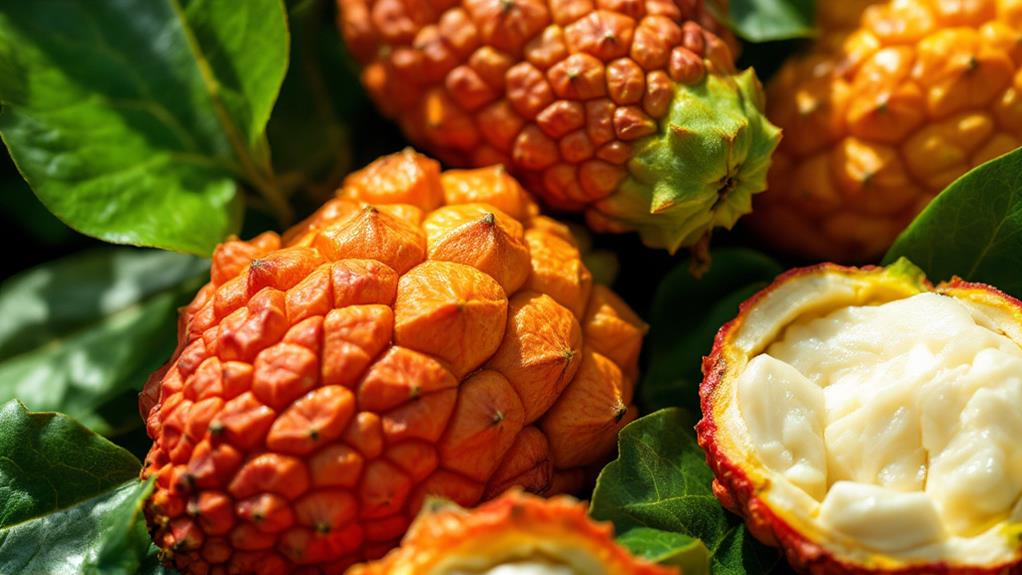
As you savor the sweet marvel of mangosteen, turn your attention to another intriguing delight from Indonesia: the snake fruit, or Salak. This exotic fruit captivates not only with its reddish-brown scaly skin that resembles a snake's scales but also with the enticing flavors hidden within. Once you peel away the hard skin, you'll uncover the firm, juicy flesh that promises a revitalizing taste adventure.
Snake fruit offers a delightful crunch, with a flavor profile that merges sweet and tangy notes reminiscent of both apple and pineapple. Each bite reveals a satisfying texture that's both crisp and juicy, making it an irresistible snack. This fruit is more than just a treat; it's packed with antioxidants, fiber, and crucial vitamins, offering a nutritious lift to your day.
Salak is harvested year-round, with varieties like Salak Pondoh being particularly sought after for their juiciness and sweetness. Regardless of enjoying it fresh or included in salads and desserts, snake fruit is a versatile enhancement to your culinary repertoire. So next time you're looking for a unique and invigorating taste from Indonesia, don't miss out on the crunch of snake fruit.
Rambutan Richness
Among the lively array of Indonesian fruits, rambutan stands out with its striking hairy exterior. This tropical delight is an oval-shaped gem that closely resembles lychee in texture and flavor. Beneath its unusual surface lies sweet and juicy flesh with a hint of acidity, reminiscent of strawberries. If you haven't tried rambutan yet, you're in for a treat.
Here's why rambutan deserves a spot on your must-try list:
- Flavor Experience: The combination of sweetness and a slight tang makes rambutan a revitalizing snack that's hard to resist.
- Health Benefits: Packed with vitamin C and iron, rambutan offers more than just great taste. It enhances your immune health, helping you fend off common illnesses.
- Seasonal Availability: Harvested from June to November, rambutan is freshest during its peak season in Indonesia, ensuring you get the best quality fruit.
When enjoying rambutan, be cautious of its bitter seed. The fruit is best savored fresh to fully appreciate its unique flavor profile. So, next time you investigate tropical fruits, make sure rambutan is on your list—you won't regret it!
Soursop Sensation
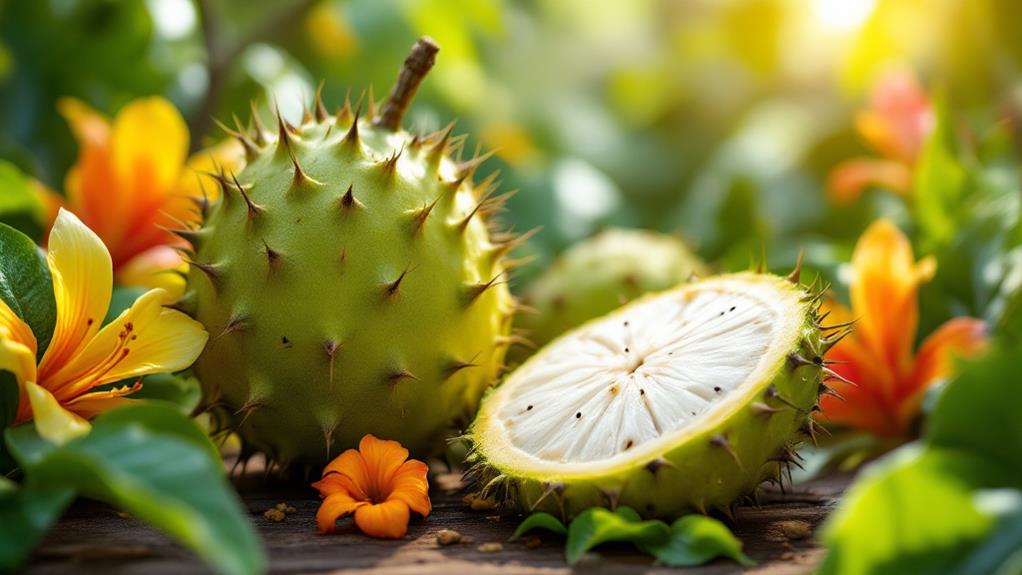
With its intriguing green, spiky exterior, soursop, or Sirsak as it's known in Indonesia, captivates both the eyes and the taste buds. Situated in the heart of Indonesia's tropical climate, this fruit offers a creamy white flesh that bursts with a sweet-and-sour flavor profile. You won't want to miss it when exploring local markets; its unique taste has made it a beloved choice for both beverages and desserts.
Soursop is not just about flavor; it's also packed with vitamin C and is believed to have anti-inflammatory and revitalizing effects. You can often find it blended with sugar syrup to create invigorating drinks perfect for a hot day. Beyond beverages, many locals use its pulp in traditional medicine, relying on its purported healing properties.
Peak season in Indonesia aligns with the tropical fruit harvest, ensuring you get the freshest soursop. Its versatility shines as it's enjoyed fresh or incorporated into a variety of culinary dishes. Regardless of you're sipping on a soursop drink or indulging in a dessert, this fruit will certainly elevate your taste adventure through Indonesia. Don't miss the chance to experience this sensational tropical delight!
Passionfruit Pizzazz
Passionfruit, or "Markisa" as it's called in Indonesia, is a delightful tropical treat that captivates with its lively flavor and nutritional benefits. Encased in a tough outer rind, its sweet and tart pulp filled with crunchy seeds is a popular ingredient in desserts and drinks. High in dietary fiber, vitamins A and C, passionfruit not only enriches flavors but also supports digestion and strengthens your immune system. You'll find this exotic fruit consistently available year-round, thanks to its tropical harvest cycle, making it a staple for locals and visitors alike.
The lively flavor of passionfruit lends itself to a variety of culinary applications. You can infuse your meals with its unique taste by trying it in:
- Juices and Smoothies: Add a tropical twist to your beverages with passionfruit's sweet and tart essence.
- Sauces and Dressings: Raise your dishes with a zesty passionfruit sauce or dressing.
- Desserts and Toppings: Use it as a topping for traditional Indonesian desserts or incorporate it into your sweet treats.
Incorporate passionfruit into your culinary repertoire and enjoy the flair it brings to your kitchen creations.
Longan Lusciousness
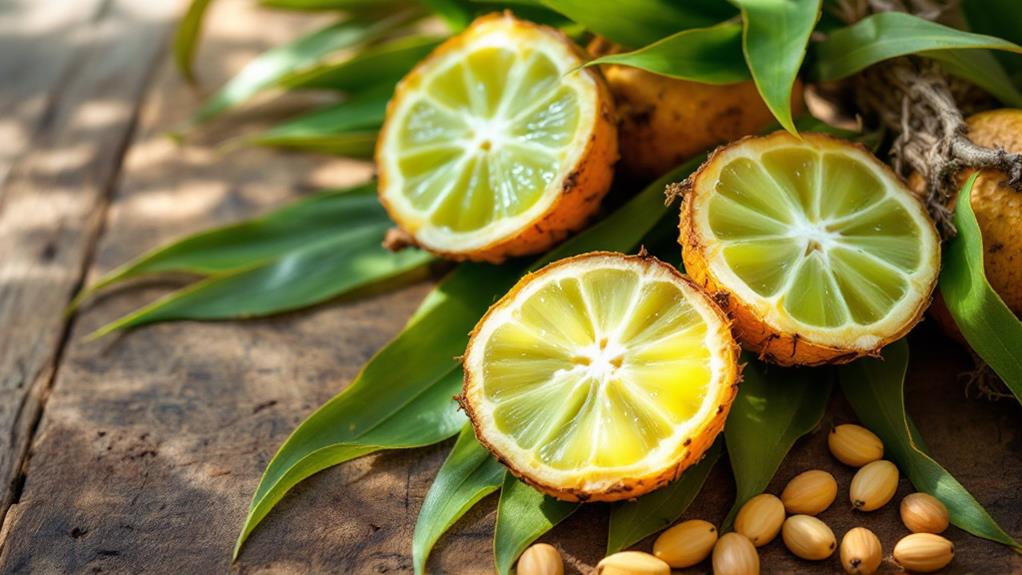
Longan, often called "dragon's eye," bursts onto the scene with its small, sweet presence and enticing flavor. With a light brown shell, this tropical fruit reveals a translucent, juicy flesh that's reminiscent of lychee. If you're exploring Indonesian markets, you'll likely spot longan in small bunches, a sign of its popularity and cultural significance.
Available from September to April, longan is a seasonal delight in Southeast Asia. You can enjoy it fresh, savoring each succulent bite, or get creative by incorporating it into soups, desserts, and traditional drinks. Adding longan to your culinary adventures introduces a unique sweetness that improves different dishes.
Beyond its delicious taste, longan offers impressive health benefits. Packed with vitamins C and B, it's a natural way to elevate your immunity and promote healthy skin. Including this fruit in your diet isn't just a treat for your taste buds, but also a boost for your wellbeing.
Salak Surprise
Salak, also known as snake fruit, instantly captures attention with its unique reddish-brown scaly skin that resembles snake scales. As you peel away the intriguing exterior, you'll find a crunchy texture and a sweet-tangy flavor that's a delightful mix of apples and pineapples. But there's more to this exotic fruit than meets the eye. Here's why you should give salak a try:
- Nutrient Powerhouse: Salak is packed with antioxidants, fiber, and vitamins, making it not only tasty but also a healthy snack option. These nutrients are essential for enhancing your immune system and promoting digestive health.
- Year-round Availability: Unlike many fruits, salak is typically harvested all year, ensuring you can enjoy its unique flavor whenever you please. The Salak Pondoh variety is particularly noted for its juicy taste, adding an extra layer of enjoyment.
- Easy Preparation: To savor snake fruit, simply peel its scaly skin carefully. Be mindful of the hard black seed inside; it's best to avoid this part as it can be quite tough on the teeth.
Dukuh Discovery
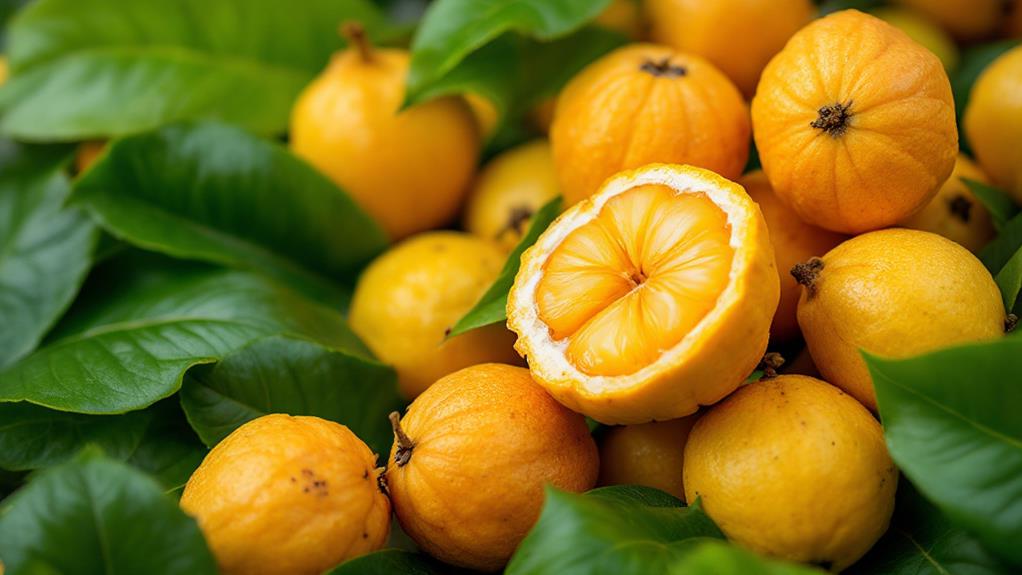
Dukuh, a gem among tropical fruits, captivates with its sweet and segmented nature, reminiscent of juicy grapes. Native to Southeast Asia, particularly Indonesia, dukuh—also known as langsat or lanzones—offers a delightful taste experience you shouldn't miss. Sporting a thin, translucent skin that's easy to peel, this fruit reveals juicy flesh that's both sweet and sour, making it an irresistible snack.
You'll find dukuh available year-round, but it truly shines in fall and winter. Its versatility is part of its charm. Enjoy it fresh, or stew it for a revitalizing drink; either way, its unique flavor is bound to please. In Indonesian cuisine, dukuh is a cherished ingredient in fruit salads known as rujak, adding a burst of flavor that complements other tropical fruits.
Beyond its taste, dukuh is rich in vitamins and antioxidants, making it a staple in traditional medicine. It's valued for its potential health benefits, contributing to overall health. Regardless of whether you're exploring Indonesian markets or trying your hand at making rujak, dukuh promises a sweet and sour adventure that celebrates the richness of Southeast Asian fruits.
Matoa Magic
Venture into the enchanting world of matoa, a unique fruit native to Indonesia, captivating your senses with its alluring blend of flavors. As you experience this tropical gem, you'll find its resemblance to mangosteen and lychee intriguing, with a tough exterior giving way to sweet and juicy flesh. Imagine biting into a matoa fruit and savoring its delectable taste, a delightful fusion of mango and papaya. It's best enjoyed fresh, so plan a visit between November and March when it's in season.
Why should matoa be on your must-try list? Here are three compelling reasons:
- Nutrient Powerhouse: Matoa is packed with vitamins C and E, offering antioxidant benefits that support your comprehensive health.
- Versatile Flavor: Its unique taste makes it a perfect enhancement to fruit salads or desserts, elevating your dishes with a tropical twist.
- Biodiversity Gem: Matoa trees thrive in Indonesia's lush climate, regardless of whether they are wild or cultivated in orchards, highlighting the region's rich biodiversity.
Don't miss the chance to investigate this enchanting fruit. Let matoa transport you to the tropical paradises of Indonesia, incorporating a burst of sweet and juicy delight to your culinary adventures.

